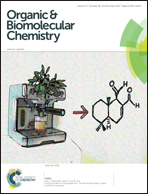A curcumin-based molecular probe for near-infrared fluorescence imaging of tau fibrils in Alzheimer's disease†
Abstract
In recent years, there has been growing interest in the near-infrared (NIR) fluorescence imaging of tau fibrils for the early diagnosis of Alzheimer's disease (AD). In order to develop a curcumin-based NIR fluorescent probe for tau fibrils, structural modification of the curcumin scaffold was attempted by combining the following rationales: the curcumin derivative should preserve its binding affinity to tau fibrils, and, upon binding to tau fibrils, the probe should show favorable fluorescence properties. To meet these requirements, we designed a novel curcumin scaffold with various aromatic substituents. Among the series, the curcumin derivative 1c with a (4-dimethylamino-2,6-dimethoxy)phenyl moiety showed a significant change in its fluorescence properties (22.9-fold increase in quantum yield; Kd, 0.77 μM; λem, 620 nm; Φ, 0.32) after binding to tau fibrils. In addition, fluorescence imaging of tau-green fluorescent protein-transfected SHSY-5Y cells with 1c confirmed that 1c detected tau fibrils in live cells.


 Please wait while we load your content...
Please wait while we load your content...